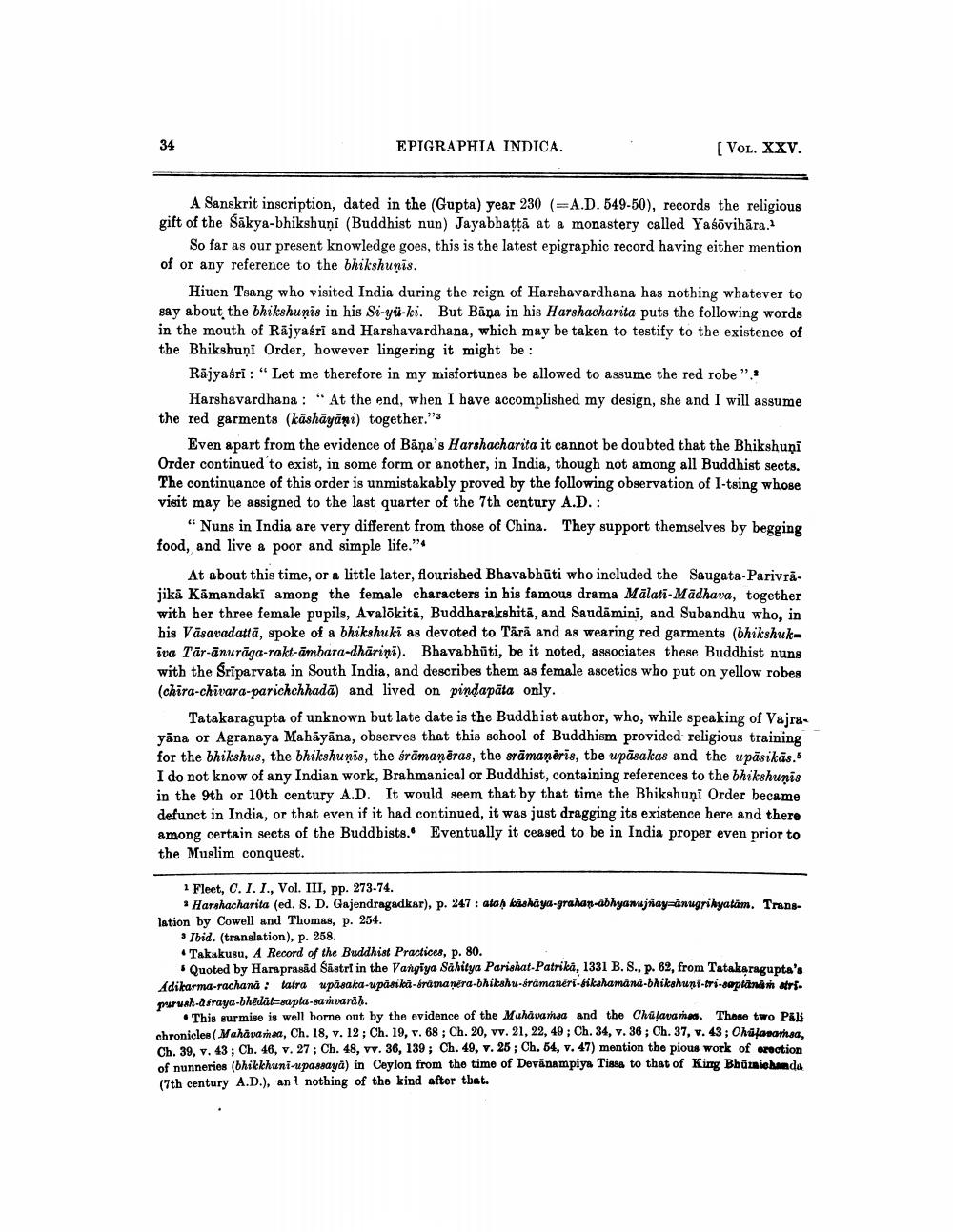________________
EPIGRAPHIA INDICA.
[Vol. XXV.
A Sanskrit inscription, dated in the (Gupta) year 230 (=A.D. 549-50), records the religious gift of the Sākya-bhiksbuni (Buddhist nun) Jayabbattā at a monastery called Yasovihāra.
So far as our present knowledge goes, this is the latest epigraphic record having either mention of or any reference to the bhikshunis.
Hiuen Tsang who visited India during the reign of Harshavardhana has nothing whatever to say about the bhikshunis in his Si-yü-ki. But Bāna in his Harshacharita puts the following words in the mouth of Rajyasri and Harshavardhana, which may be taken to testify to the existence of the Bhikshuni Order, however lingering it might be :
Rajyasri : "Let me therefore in my misfortunes be allowed to assume the red robe":
Harshavardhana : “At the end, when I have accomplished my design, she and I will assume the red garments (kāshāyāni) together."
Even apart from the evidence of Bāņa's Harshacharita it cannot be doubted that the Bhikshuņi Order continued to exist, in some form or another, in India, though not among all Buddhist sects. The continuance of this order is unmistakably proved by the following observation of I-tsing whose visit may be assigned to the last quarter of the 7th century A.D.:
“Nuns in India are very different from those of China. They support themselves by begging food, and live a poor and simple life."
At about this time, or a little later, flourished Bhavabhūti who included the Saugata-Parivrăjikā Kāmandaki among the female characters in his famous drama Mālati-Madhava, together with her three female pupils, Avalokitā, Buddharakshită, and Saudāmini, and Subandhu who, in his Vāsavadattă, spoke of a bhikshuki as devoted to Tără and as wearing red garments (bhikshukiva Tār-ānurāga-rakt-āmbara-dhāriņi). Bhavabhūti, be it noted, associates these Buddhist nuns with the Sriparvata in South India, and describes them as female ascetics who put on yellow robes (chira-chivara-parichchhadā) and lived on pindapāta only.
Tatakaragupta of unknown but late date is the Buddhist author, who, while speaking of Vajra yāna or Agranaya Mahāyāna, observes that this school of Buddhism provided religious training for the bhikshus, the bhikshunīs, the śrāmaņēras, the srāmaņēris, tbe upāsakas and the upāsikās. I do not know of any Indian work, Brahmanical or Buddhist, containing references to the bhikshunis in the 9th or 10th century A.D. It would seem that by that time the Bhikshuņi Order became defunct in India, or that even if it had continued, it was just dragging its existence here and there among certain sects of the Buddbists. Eventually it ceased to be in India proper even prior to the Muslim conquest.
1 Fleet, C.I.I., Vol. III, pp. 273-74.
* Harshacharita (ed. 8. D. Gajendragadkar), p. 247 : atah kashaya-grahan-abhyanujñay=ănugrikyatām. Translation by Cowell and Thomas, p. 254.
• Ibid. (translation), p. 258. • Takukusu, A Record of the Buddhist Practices, p. 80.
. Quoted by Haraprasad Sastrf in the Vangiya Sahitya Parishat.Patrika, 1331 B.S., p. 62, from Tatakaragupta's Adikarma-rachana : latra u pasaka-upåsika-Srimanera-bhikshu-framandri-fikshamana-bhikshuni-tri-soplandh atri. puruah-afraya-bhedatsapla-sarvanih.
This surmise is well borne out by the evidence of the Muhavamsa and the Chalava med. Those two Pali chronicles (Mahavamaa, Ch.18, v. 12; Ch. 19, v. 68; Ch. 20, vv. 21, 22, 49; Ch. 34, v. 36; Ch. 37, v. 43; Ohilanamea. Ch. 39, v. 43; Ch. 46, v. 27; Ch. 48, vv. 36, 139, Ch. 49, v. 28; Ch. 54, v. 47) mention the pious work of orection of punneries (Bhikkhuni-upassaya) in Ceylon from the time of Devanampiya Tissa to that of King Bhüzniehanda (7th century A.D.), an nothing of the kind after that.




